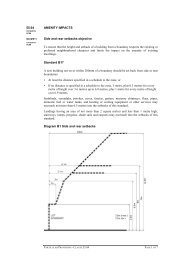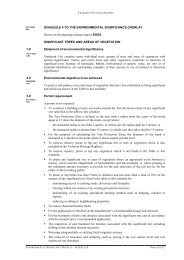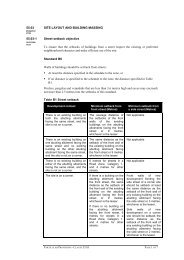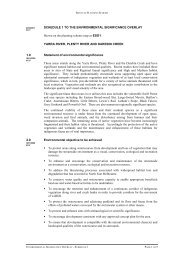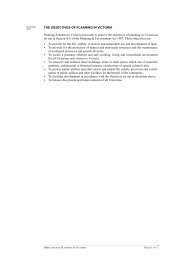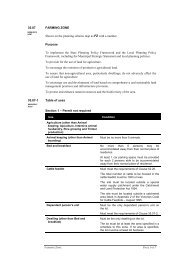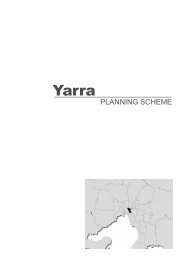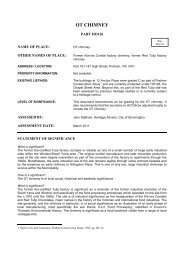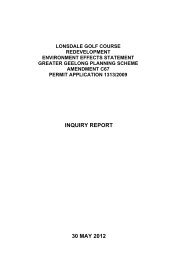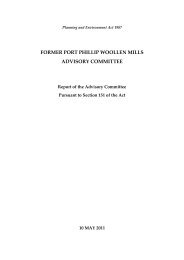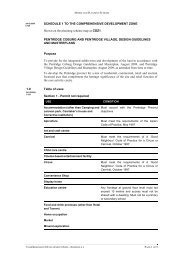environmental significance overlay - schedule 1 - Victoria's Planning ...
environmental significance overlay - schedule 1 - Victoria's Planning ...
environmental significance overlay - schedule 1 - Victoria's Planning ...
Create successful ePaper yourself
Turn your PDF publications into a flip-book with our unique Google optimized e-Paper software.
24/09/2009<br />
C123<br />
CARDINIA PLANNING SCHEME<br />
SCHEDULE 1 TO THE ENVIRONMENTAL SIGNIFICANCE OVERLAY<br />
Shown on the planning scheme map as ESO1.<br />
NORTHERN HILLS<br />
1.0 Statement of <strong>environmental</strong> <strong>significance</strong><br />
19/01/2006<br />
VC37<br />
The hills to the northern part of the municipality (generally to the north of the Princes<br />
Highway) is an area with significant landscape and <strong>environmental</strong> values. The area is<br />
characterised by a geology of Devonian Granitic and Sulrian Sediment origin, moderate to<br />
steep slopes, and areas of remnant vegetation. These characteristics contribute to<br />
<strong>environmental</strong> values including landscape quality, water quality, and habitat of botanical<br />
and zoological <strong>significance</strong>. These characteristics are also a significant factor in terms of<br />
<strong>environmental</strong> hazards including erosion and fire risk.<br />
2.0 Environmental objective to be achieved<br />
19/01/2006<br />
VC37<br />
To protect the significant <strong>environmental</strong> and landscape values in the northern hills area.<br />
To ensure that the siting and design of buildings and works does not adversely impact<br />
on <strong>environmental</strong> values including the diverse and interesting landscape, areas of<br />
remnant vegetation, habitat of botanical and zoological <strong>significance</strong> and water quality.<br />
To ensure that the siting and design of buildings and works addresses <strong>environmental</strong><br />
hazards including slope, erosion and fire risk.<br />
3.0 Permit requirement<br />
24/09/2009<br />
C123<br />
A permit is not required to construct a building or construct or carry out works provided all<br />
of the following requirements are met:<br />
Building materials must be non-reflective or subdued colours which complement the<br />
environment.<br />
The height of any building must not exceed 7 metres above natural ground level.<br />
The works must not involve the excavation of land exceeding 1 metre or filling of land<br />
exceeding 1 metre and any disturbed area must be stabilised by engineering works or<br />
revegetation to prevent erosion.<br />
The slope of the land on which the buildings or works are undertaken must not exceed<br />
20%.<br />
The buildings and works must not result in the removal or destruction of native<br />
vegetation (including trees, shrubs, herbs, sedges and grasses) within an area of<br />
botanical or zoological <strong>significance</strong> as shown on the mapped information provided by<br />
the Department of Sustainability and Environment, with the exception of Sweet<br />
Pittosporum (Pittosporum undulatum).<br />
If the building is a new dwelling, it must not be within a designated bushfire prone area<br />
under Part 6.4 of the Building Regulations 1994. This requirement does not apply to an<br />
extension to an existing dwelling.<br />
If the building is an extension to an existing dwelling.<br />
ENVIRONMENTAL SIGNIFICANCE OVERLAY - SCHEDULE 1 PAGE 1 OF 6
CARDINIA PLANNING SCHEME<br />
If the building is an outbuilding ancillary to a dwelling, the gross floor area of all<br />
outbuildings on the land must not exceed 120 square metres.<br />
If the building is in a Rural Zone and is associated with the existing use of the land for<br />
the purposes of agriculture, the gross floor area of the building must not exceed 160<br />
square metres.<br />
If a building envelope is specified on the endorsed plan which forms part of the<br />
planning permit for subdivision which created the lot, any building must be located<br />
within the building envelope.<br />
A permit is not required to remove, destroy or lop any vegetation if:<br />
The vegetation is an <strong>environmental</strong> weed known as Sweet Pittosporum (Pittosporum<br />
undulatum).<br />
The vegetation is dead or diseased as a result of natural circumstances or the spread of<br />
noxious weeds and which has been assessed as being suitable for removal by an<br />
authorised officer of the responsible authority.<br />
It is the minimum extent necessary to maintain utility services for the transmission of<br />
water, sewage, gas, electricity, electronic communications or the like, provided that the<br />
removal, destruction or lopping is undertaken in consultation with the responsible<br />
authority.<br />
Necessary for the construction or maintenance by the Cardinia Shire Council of works<br />
including any road, drain, essential service or public facility.<br />
Necessary for the construction or maintenance of a fence provided the vegetation is the<br />
minimum required to be removed and is within any of the following:<br />
1.5 metres either side of a title boundary which does not abut a road reserve and the<br />
consent of the adjoining property owner has been obtained.<br />
2.0 metres within a title boundary abutting a road reserve.<br />
1.5 metres either side of an internal fenceline.<br />
This exemption does not apply to land within an area of botanical or zoological<br />
<strong>significance</strong> as shown on the mapped information provided by the Department of<br />
Sustainability and Environment.<br />
The vegetation is seedlings or regrowth less than 5 years old and the land is being<br />
maintained for cultivation or pasture.<br />
It is for the cutting of reasonable amounts of wood for personal use by the owner or<br />
occupier of the land.<br />
It is the removal of any vegetation from an existing dam wall.<br />
It is a grass species and the removal, slashing or cutting is associated with an existing<br />
residential or permitted use or part of an existing farming operation.<br />
The vegetation is an <strong>environmental</strong> weed (as defined in the following table) and the<br />
diameter of the vegetation when measured 1 metre above natural ground level does not<br />
exceed 30 centimetres.<br />
Common name Botanical name<br />
African Lily<br />
Alkante<br />
American Aspen<br />
Angled Onion<br />
Agapanthus praecox ssp. orientalis<br />
Pentaglottis serpvirens<br />
Populus tremuloides<br />
Allium triquetrum<br />
ENVIRONMENTAL SIGNIFICANCE OVERLAY - SCHEDULE 1 PAGE 2 OF 6
Apple<br />
Arum Lily<br />
Asparagus Fern<br />
Banana Passionfruit<br />
Belladonna Lily<br />
Berry-flower Heath<br />
Bindweeds<br />
Blackberry<br />
Black Locust<br />
Bloukeur (Pinnate Scurf-Pea)<br />
Blue-bell Creeper<br />
Blue Periwinkle<br />
Bridal Creeper<br />
Boneseed<br />
Bulbil Watsonia<br />
Butterfly Bush<br />
Cape Broom<br />
Cape Ivy<br />
Cape Wattle<br />
Caster Oil Plant<br />
Caucasian Ash<br />
Cedar Wattle<br />
Cestrum<br />
Cherry laurel<br />
Cherry Plum<br />
Common Dipogon (Dolichos)<br />
Common Evening Primrose<br />
Common Forget-me-not<br />
Cootamundra Wattle<br />
Cotoneaster<br />
Creeping Buttercup<br />
Darwin's Berberry<br />
Early Black Wattle<br />
English Broom<br />
English Ivy<br />
CARDINIA PLANNING SCHEME<br />
Malus spp<br />
Zantedeschia aethiopica<br />
Myrsiphyilum scadens<br />
Passiflora sp. aff. Mollissima (syn. Jacsonia<br />
mollissima)<br />
Amaryllis belladonna<br />
Erica baccans<br />
Convolvulus spp.<br />
Rubus fruticosos spp. agg.<br />
Robina pseudacacia<br />
Psoralea pinnata<br />
Sollya heterophylla<br />
Vinca major<br />
Myrisphyllum asparagoides<br />
Chrysanthemoides monilifera<br />
Watsonia meriana<br />
Buddleia variabilis (syn. Veitchianus)<br />
Genista monspessulana<br />
Delairea odorata<br />
Paraserianthis lopantha<br />
Rincinus commonis<br />
Fraxinus oxycarpa<br />
Acacia elate<br />
Cestrum elegans<br />
Prunus laurocerasus<br />
Prunus cerasifera<br />
Dipogon lignosus<br />
Oenothera stricta<br />
Myosotis sylvatica<br />
Acacia baileyana<br />
Cotoneaster spp.<br />
Ranunculus repens<br />
Berberis darwinii<br />
Acacia decurrens<br />
Cytisus scoparius<br />
Hedra helix<br />
ENVIRONMENTAL SIGNIFICANCE OVERLAY - SCHEDULE 1 PAGE 3 OF 6
Euryops<br />
Evergreen Dogwood<br />
False Wattle<br />
Fennel<br />
Firethorns<br />
Flax Leaf Broom<br />
Fragrant Violet<br />
Giant Honey Myrtle<br />
Golden Wreath Wattle<br />
Great Mullein<br />
Hawthorn<br />
Hemlock<br />
Himilayan Honeysuckle<br />
Holly<br />
Honey Myrtle<br />
Inkweed<br />
Italian Buckthorn<br />
Japanese Honeysuckle<br />
Karamu<br />
Karo<br />
Laurestinus<br />
Manna Ash<br />
Mirror Bush<br />
Montbretia<br />
Montery Pine<br />
Morning Glory<br />
Myrtle Leaf Milkwort<br />
Nasturtium<br />
Pampas Grass<br />
Peruvian Lily<br />
Plum<br />
Portugal Laurel<br />
Prickly Pear<br />
Privet<br />
Quaking Grass<br />
CARDINIA PLANNING SCHEME<br />
Euryops abrotanifolius<br />
Cornus capitata<br />
Albizia lopantha<br />
Foeniculum vulgare<br />
Pyracantha spp.<br />
Genista linifolia<br />
Viola odorata<br />
Melaleuca armillaris<br />
Acacia saligna<br />
Verbascum thapsus<br />
Crategus monogyna<br />
Conium maculatum<br />
Leycesteria formosa<br />
Ilex aquifolium<br />
Melaleuca hypericifolia<br />
Phytolacca octandra<br />
Rhamnus alaternus<br />
Lonicera japonica<br />
Coprosma robusta<br />
Pittosporum crassifolium<br />
Vibernum timus<br />
Fraxinus ornus<br />
Coprosma repens<br />
Crocosmia x crocosmiifolia<br />
Pinus radiata<br />
Ipomoea indica<br />
Polygalia myrtifolia<br />
Tropaeolum majus<br />
Cortaderai selloana<br />
Alstromeria aurea<br />
Prunus spp.<br />
Prunus lusitanica<br />
Opuntia aurantiaca<br />
Ligustrum vulgare<br />
Briza maxima<br />
ENVIRONMENTAL SIGNIFICANCE OVERLAY - SCHEDULE 1 PAGE 4 OF 6
Red Cestrum<br />
Rosy Watsonia<br />
Sallow Wattle<br />
Shasta Daisy<br />
Smilax<br />
Spanish Heath<br />
Sticky Hop Bush<br />
Strawberry Tree<br />
Sweet Briar<br />
Sweet Hakea<br />
Sweet Pea<br />
Sycamore Maple<br />
Tall Fleabane<br />
Taupata<br />
Tree Lucerne<br />
Tree Tobacco<br />
Tutsan<br />
Wandering Jew<br />
White Arum Lily<br />
White Sallow Wattle<br />
Willow<br />
Willow Hakea<br />
Wood Violet<br />
CARDINIA PLANNING SCHEME<br />
Cestrum elegans<br />
Watsonia boronica<br />
Acacia longifolia<br />
Chrysanthem maximum<br />
Myrsiphyilum asparagoides<br />
Erica lusitanica<br />
Dodonea viscosa<br />
Arbutus unedo<br />
Rosa rubiginosa<br />
Hakea sauveolens<br />
Lathyrus latifolius<br />
Acer pseudo-plantanus<br />
Conyza bonariensis<br />
Coprosma repens<br />
Cytisis palmensis<br />
Solanum mauritianum<br />
Hypericum androsaemum<br />
Tradescantia fluminensis<br />
Zantedeschia aethopia<br />
Acacia floribunda<br />
Salix spp.<br />
Hakea salicifolia<br />
Viola riviniana<br />
It is the minimum extent necessary to construct an approved building or construct or<br />
carry out approved works.<br />
Within 10 metres of a dwelling or within 10 metres of an outbuilding ancillary to the<br />
dwelling on a lot of at least 0.4 hectare.<br />
Within 6 metres of a dwelling or within 6 metres of an outbuilding ancillary to the<br />
dwelling on a lot of less than 0.4 hectare.<br />
Necessary for works associated with the normal operation of the Puffing Billy Tourist<br />
Railway.<br />
The vegetation is required to be pruned or lopped (but not removed) as part of normal<br />
domestic or horticultural practice for the species.<br />
Applications within an area of botanical or zoological <strong>significance</strong> as shown on the mapped<br />
information provided by the Department of Sustainability and Environment must be<br />
referred in accordance with Section 55 of the Act to the referral authority specified in<br />
Clause 66.04 or a <strong>schedule</strong> to that clause unless in the opinion of the responsible authority<br />
the proposal satisfies requirements or conditions previously agreed in writing between the<br />
responsible authority and the Department of Sustainability and Environment.<br />
ENVIRONMENTAL SIGNIFICANCE OVERLAY - SCHEDULE 1 PAGE 5 OF 6
4.0 Decision guidelines<br />
19/01/2006<br />
VC37<br />
CARDINIA PLANNING SCHEME<br />
Before deciding on an application, the responsible authority must consider:<br />
The Land Capability Study for the Cardinia Shire (February 1997).<br />
The protection and enhancement of the natural environment and character of the area.<br />
The retention of remnant vegetation and habitat, and the need to plant vegetation along<br />
waterways, gullies, ridgelines and property boundaries.<br />
The impact of any buildings and works on areas of remnant vegetation, and habitat of<br />
botanical and zoological <strong>significance</strong>.<br />
The impact of proposed buildings and works on the landscape character of the area,<br />
including prominent ridgelines and significant views.<br />
Measures to address <strong>environmental</strong> hazards or constraints including slope, erosion,<br />
drainage, salinity and fire.<br />
The protection of waterways and water quality through the appropriate management of<br />
effluent disposal, erosion and sediment pollution.<br />
ENVIRONMENTAL SIGNIFICANCE OVERLAY - SCHEDULE 1 PAGE 6 OF 6



